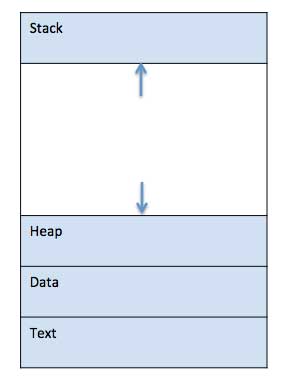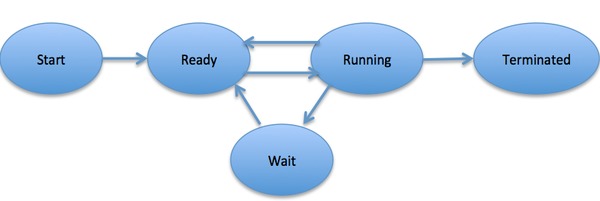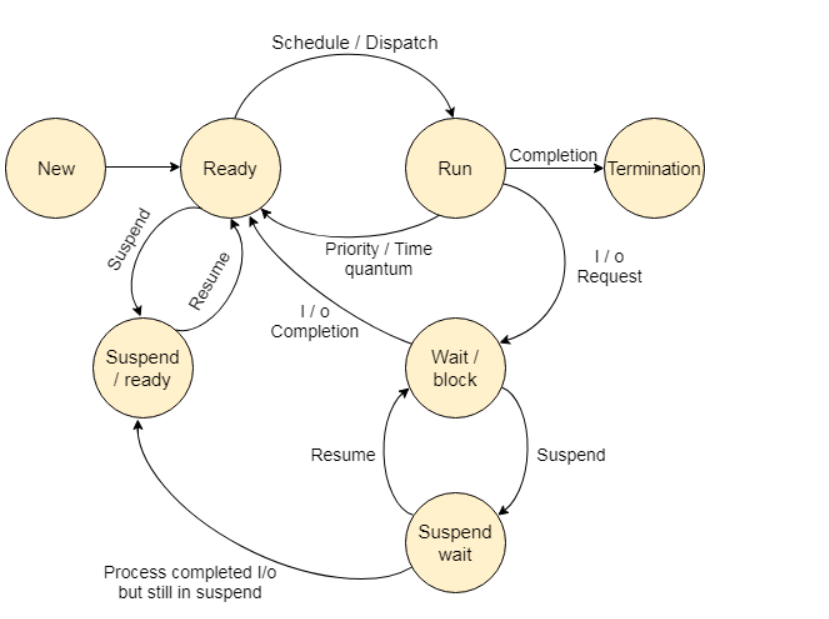Process
A process is basically a program in execution. The execution of a process must progress in a sequential fashion. A process is defined as an entity which represents the basic unit of work to be implemented in the system.
To put it in simple terms, we write our computer programs in a text file and when we execute this program, it becomes a process which performs all the tasks mentioned in the program.
When a program is loaded into the memory and it becomes a process, it can be divided into four sections ─ stack, heap, text and data. The following image shows a simplified layout of a process inside main memory.

| S.N. | Component & Description |
|---|---|
| 1 | Stack The process Stack contains the temporary data such as method/function parameters, return address and local variables. |
| 2 | Heap
This is dynamically allocated memory to a process during its run time. |
| 3 | Text
This includes the current activity represented by the value of Program Counter and the contents of the processor’s registers. |
| 4 | Data This section contains the global and static variables. |
Program
A program is a piece of code which may be a single line or millions of lines. A computer program is usually written by a computer programmer in a programming language. For example, here is a simple program written in C programming language −
#include <stdio.h> int main() { printf("Hello, World! \n"); return 0; }
A computer program is a collection of instructions that performs a specific task when executed by a computer. When we compare a program with a process, we can conclude that a process is a dynamic instance of a computer program.
A part of a computer program that performs a well-defined task is known as an algorithm. A collection of computer programs, libraries and related data are referred to as a software.
Process Life Cycle
When a process executes, it passes through different states. These stages may differ in different operating systems, and the names of these states are also not standardized.
In general, a process can have one of the following five states at a time.
| S.N. | State & Description |
|---|---|
| 1 | Start/New This is the initial state when a process is first started/created. |
| 2 | Ready
The process is waiting to be assigned to a processor. Ready processes are waiting to have the processor allocated to them by the operating system so that they can run. Process may come into this state after Start state or while running it by but interrupted by the scheduler to assign CPU to some other process. |
| 3 | Running
Once the process has been assigned to a processor by the OS scheduler, the process state is set to running and the processor executes its instructions. |
| 4 | Waiting/Block
Process moves into the waiting state if it needs to wait for a resource, such as waiting for user input, or waiting for a file to become available. |
| 5 | Terminated or Exit Once the process finishes its execution, or it is terminated by the operating system, it is moved to the terminated state where it waits to be removed from main memory. |


Suspend ready
A process in the ready state, which is moved to secondary memory from the main memory due to lack of the resources (mainly primary memory) is called in the suspend ready state.
If the main memory is full and a higher priority process comes for the execution then the OS have to make the room for the process in the main memory by throwing the lower priority process out into the secondary memory. The suspend ready processes remain in the secondary memory until the main memory gets available.
Suspend wait
Instead of removing the process from the ready queue, it’s better to remove the blocked process which is waiting for some resources in the main memory. Since it is already waiting for some resource to get available hence it is better if it waits in the secondary memory and make room for the higher priority process. These processes complete their execution once the main memory gets available and their wait is finished.
Operations on the Process
1. Creation
Once the process is created, it will be ready and come into the ready queue (main memory) and will be ready for the execution.
2. Scheduling
Out of the many processes present in the ready queue, the Operating system chooses one process and start executing it. Selecting the process which is to be executed next, is known as scheduling.
3. Execution
Once the process is scheduled for the execution, the processor starts executing it. Process may come to the blocked or wait state during the execution then in that case the processor starts executing the other processes.
4. Deletion/killing
Once the purpose of the process gets over then the OS will kill the process. The Context of the process (PCB) will be deleted and the process gets terminated by the Operating system.
Process Control Block (PCB)
A Process Control Block is a data structure maintained by the Operating System for every process. The PCB is identified by an integer process ID (PID). A PCB keeps all the information needed to keep track of a process as listed below in the table −
| S.N. | Information & Description |
|---|---|
| 1 | Process State
The current state of the process i.e., whether it is ready, running, waiting, or whatever. |
| 2 | Process privileges
This is required to allow/disallow access to system resources. |
| 3 | Process ID
Unique identification for each of the process in the operating system. |
| 4 | Pointer
A pointer to parent process. |
| 5 | Program Counter
Program Counter is a pointer to the address of the next instruction to be executed for this process. |
| 6 | CPU registers
Various CPU registers where process need to be stored for execution for running state. |
| 7 | CPU Scheduling Information
Process priority and other scheduling information which is required to schedule the process. |
| 8 | Memory management information
This includes the information of page table, memory limits, Segment table depending on memory used by the operating system. |
| 9 | Accounting information
This includes the amount of CPU used for process execution, time limits, execution ID etc. |
| 10 | IO status information
This includes a list of I/O devices allocated to the process. |
The architecture of a PCB is completely dependent on Operating System and may contain different information in different operating systems. Here is a simplified diagram of a PCB −

The PCB is maintained for a process throughout its lifetime, and is deleted once the process terminates.
Related Links to Operating System topics
Operating system Course content
- Operating System-Functions and History
- Generations of Operating System
- Functions of an Operating System
- Components of Operating System
- Types of Operating System
- Services of Operating System
- Properties of Operating System
- Processes in Operating System
- Process Scheduling in Operating System
Lab Practice Task
- Introduction to Linux Ubunto
- Installation with virtual Box
- Writing Linux Commands
- Navigation in File System and Directory Management in Ubunto using CLI
- File Handling and I/O Redirection In Ubunto
- File Access Permission in Linux
- Text Processing Tools and Basic System Configuration Tools in Linux
- Package Management in Linux
- How to manage processes in Linux
- Compiling and Executing C++ programs in Linux
- System Calls
- Introduction To Shell Programming
#Operating System complete course #Operating System past paper #Operating System-project #Computer Science all courses #operating system Problem with source code#University Past Paper #Programming language #Question paper #old paper #Operating System-Functions and History #Generations of Operating System #Functions of an Operating System #Components of Operating System #Types of Operating System #Services of Operating System #Properties of Operating System #Processes in Operating System #Process Scheduling in Operating System #Introduction to Linux Ubunto #Installation with virtual Box #Writing Linux Commands #Navigation in File System and Directory Management in Ubunto using CLI #File Handling and I/O Redirection In Ubunto #File Access Permission in Linux #Text Processing Tools and Basic System Configuration Tools in Linux #Package Management in Linux #How to manage processes in Linux #Compiling and Executing C++ programs in Linux #System Calls #Introduction To Shell Programming

